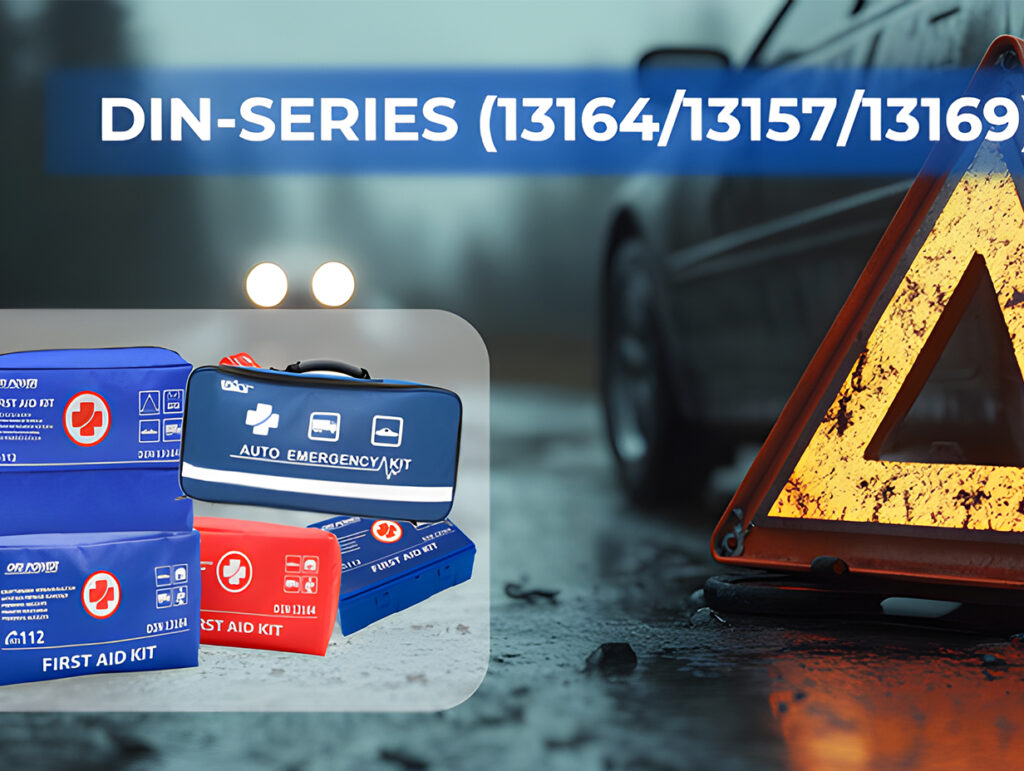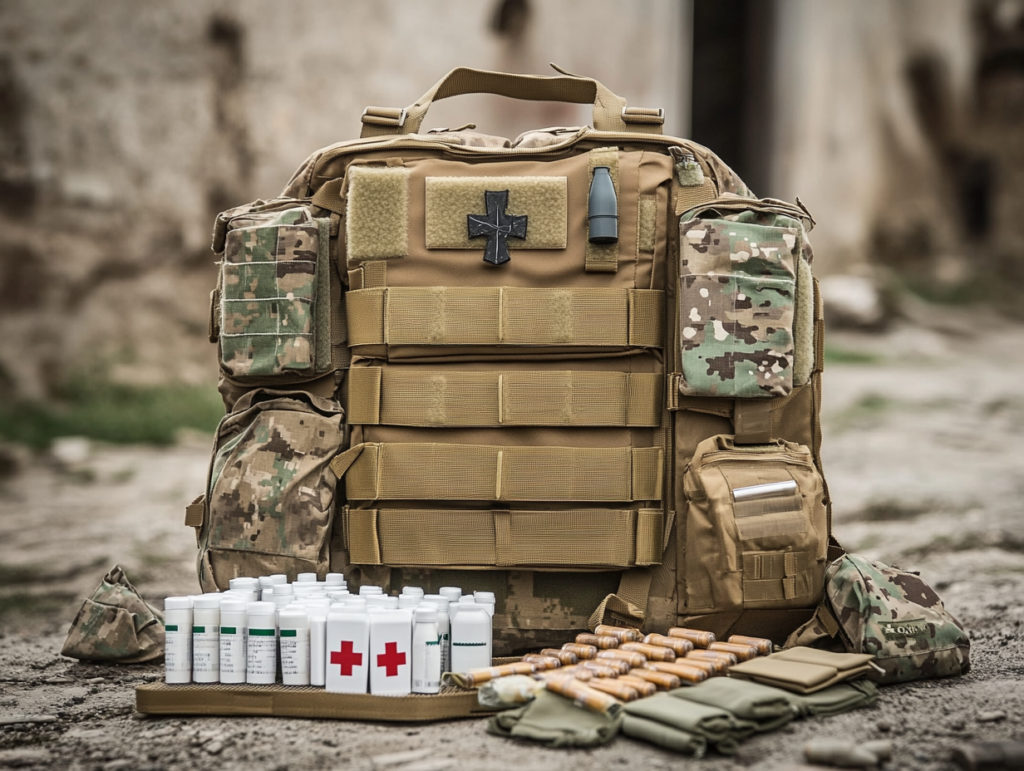In today’s society, automobiles have become an indispensable means of transportation in people’s lives. With the continuous improvement of people’s attention to travel safety, the equipment of first aid kits in automobiles has gradually come into the public eye. It is not only a powerful helper in dealing with sudden accidents but also a crucial line of defense to ensure the life and health of vehicle occupants. So, what exactly are the equipment standards of first aid kits in the automotive industry? And what development trends do they present? Let’s explore them in depth.
I. Current Equipment Standards
(1) Standards in the European Union Region
Regulations in the European Union mandate that new vehicles must be equipped with first aid kits conforming to specific standards. These kits typically house basic wound treatment supplies. For instance, adhesive bandages of various specifications are available to halt bleeding from small wounds and safeguard the wound surface. Sterile gauze and bandages serve to manage the dressing of somewhat larger bleeding areas and assist in immobilizing the injured part, preventing the injury from worsening. Additionally, disinfected wet wipes or iodine swabs are present to promptly clean the wound, minimizing the risk of infection. First aid manuals are commonly included, visually guiding vehicle occupants on the proper utilization of these first aid items during emergencies and facilitating simple self-rescue and mutual rescue operations.
(2) Standards in the United States
Some states in the United States have similar stipulations, albeit with minor differences in particulars. Besides the aforementioned conventional items, given certain special geographical features and prevalent accidents in the local context, currently, some first aid kits incorporate anti-mosquito bite ointment, sunburn relief spray, and the like. This is due to the vast territorial expanse of the US. When vehicle occupants embark on long journeys, especially to suburbs or mountainous areas, the likelihood of mosquito bites or sunburns is relatively high. These supplementary medications can promptly alleviate discomfort and avert minor issues from snowballing into major problems.
II. Future Development Trends
(1) Personalized Customization: Catering to Diverse Needs
Personalized customization is set to permeate deeply into the automotive first aid kit domain to meet the increasingly varied demands of vehicle occupants.
For Outdoor Enthusiasts
Car owner groups passionate about outdoor adventures, such as off-road aficionados frequently traversing mountain forests, will receive highly targeted first aid kit configurations. Alongside conventional adhesive bandages, gauze, and bandages, professional outdoor first aid essentials will be incorporated. A prime example is a lightweight yet high-strength carbon fiber fracture fixation splint, capable of effectively immobilizing fractured parts without burdening the injured with excessive weight. In light of the potential risk of venomous snake and scorpion bites in the wild, multiple types of antivenom sera and snakebite antidote tablets will be provided, accompanied by detailed usage instructions and illustrated guides for identifying different poisons, ensuring precise treatment when it matters most.
For Business Travelers
Business vehicle users have distinct requirements. Given their constant travels for business negotiations, long hours of driving and intense workloads often precipitate physical discomfort. First aid kits tailored for such vehicles may feature heat compress patches to relieve cervical and lumbar pain, as well as small portable oxygen generators and nitroglycerin tablets to address sudden heart problems, safeguarding their busy business trips.
For Family Travel
Family travel constitutes a significant portion of automotive usage scenarios. First aid kits designed for family sedans will comprehensively factor in the special conditions of children and the elderly. A dedicated electronic thermometer for children, offering accurate measurements and convenient readings, paired with brightly colored, cartoon-shaped cooling patches, can rapidly reduce fever through physical cooling when kids fall ill, alleviating their discomfort. An emergency call device for the elderly enables them to reach preset family numbers or the emergency center with a single click. Coupled with emergency medications for common cardiovascular diseases in the elderly, like Suxiao Jiuxin Pills, it provides all-round protection for family members’ health.
(2) Intelligent Integration: Revolutionizing First Aid Kits
Intelligence is poised to reshape the form and function of automotive first aid kits.
Real-time Item Tracking
With the aid of Internet of Things technology, chip sensors nestled within the first aid kit can monitor the status of each first aid item in real-time. Not only can they accurately keep tabs on the remaining shelf life of medications but also tally the quantity of consumables such as adhesive bandages and gauze. Once the data nears the threshold, prominent reminder notifications will be dispatched via the vehicle-mounted intelligent central control screen or the linked mobile APP, ensuring vehicle owners stay informed about the kit’s completeness and can replenish it promptly.
Emergency Response Enhancement
When an emergency strikes, intelligent first aid kits can interface seamlessly with the vehicle’s intelligent system. In the event the vehicle’s collision sensor detects a severe accident and triggers the airbag deployment, the built-in positioning module of the first aid kit will activate automatically. Through satellite positioning technology, it will swiftly transmit the precise vehicle location information to the rescue center, nearby hospitals, and preset emergency contacts, with the error confined to a minuscule range, Getting the critical minutes for the rapid arrival of rescue forces.
On-site Vital Sign Monitoring
Moreover, some high-end intelligent first aid kits will be outfitted with simple vital sign monitoring devices, such as a wristband monitor capable of quickly gauging heart rate, blood pressure, and blood oxygen saturation. Before the arrival of rescue personnel, the vehicle owner or on-site personnel can utilize it to preliminarily assess the physical condition of the injured person and relay the data to the arriving medical staff in real-time, making subsequent treatment more targeted and efficient.
(3) Application of Environmental Protection Materials: A Sustainable Shift
In the current climate where environmental protection is deeply ingrained in people’s consciousness, material innovation in automotive first aid kits is essential.
Eco-friendly Packaging
Starting from the outer packaging, degradable paper materials or bio-based plastics are gradually supplanting traditional polyethylene and polypropylene plastics. Once discarded, these novel packaging materials can decompose into harmless carbon dioxide, water, and biomass within a few months to a year through the action of microorganisms in nature, substantially alleviating the environmental strain caused by landfill or incineration.
Green Medical Consumables
The internal dressings, bandages, and other medical consumables are also undergoing a comprehensive “green makeover”. Organic cotton gauze, prized for its natural and chemical-free attributes, has emerged as the top choice for gauze, effectively warding off the risk of wound infection while meeting environmental standards. Absorbable hemostatic materials are forsaking previous formulations laden with heavy metals like mercury and silver in favor of new hemostatic agents based on natural polymers such as plant polysaccharides and proteins, which exhibit excellent hemostatic efficacy and are environmentally friendly.
Sustainable Fixing Tapes
Even the fixing tape is transitioning, with water-based acrylate serving as the adhesive in lieu of the traditional solvent-based glue. This reduces the emission of volatile organic compounds (VOCs), and upon disposal, its decomposition process generates no harmful pollution. This holistic application of environmental protection materials not only empowers automotive first aid kits to safeguard life but also contributes to the global ecosystem, forging a win-win scenario for sustainable development.
The equipment standards of first aid kits in the automotive industry are in a constant state of evolution, mirroring the growing awareness of safety. Their future development brims with limitless potential. Whether it’s the trends of personalization, intelligence, or environmental protection, the ultimate aim is to furnish vehicle occupants with more comprehensive and efficient life safety protection. It is hoped that car owners will come to appreciate the significance of first aid kits and enjoy more worry-free journeys.


